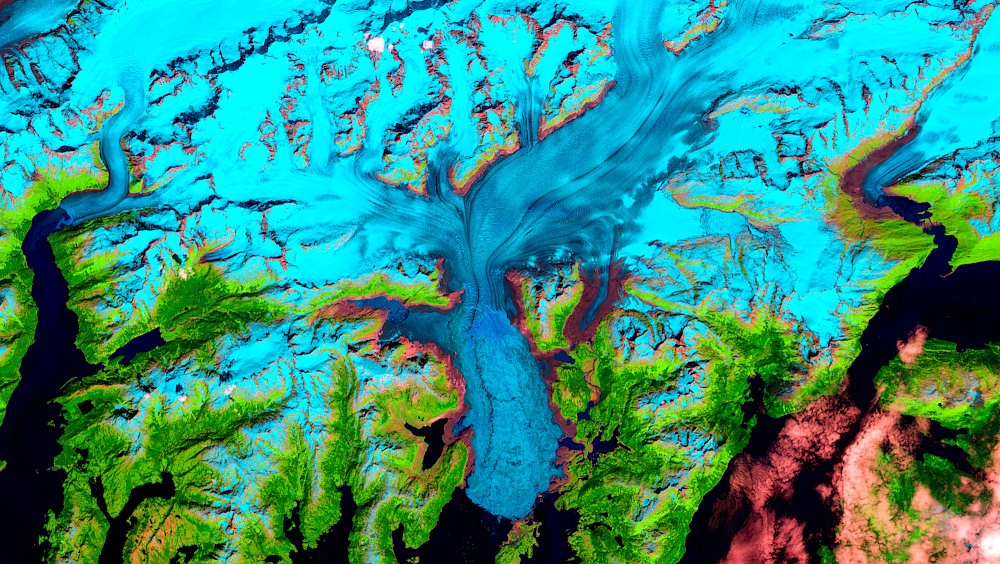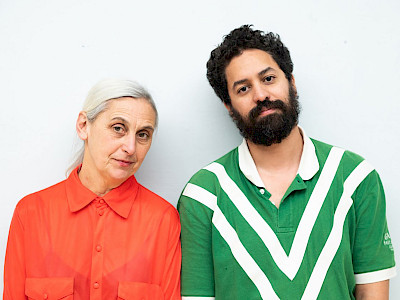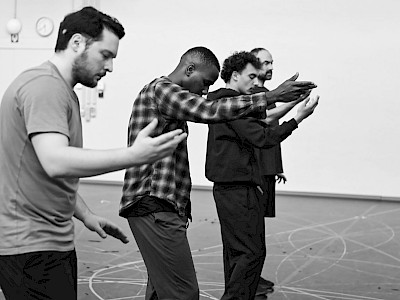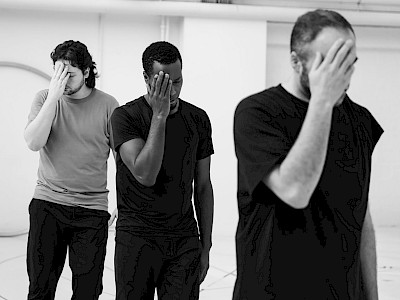11.05, 12.05, 14 — 17.05, 22 — 26.05, 28 — 31.05.2024
Anne Teresa De Keersmaeker, Radouan Mriziga, / Rosas, / A7LA5 Brussels-Marrakech
Il Cimento dell’Armonia e dell’Inventione
dance — premiere
Antonio Vivaldi composed The Four Seasons 300 years ago. Can we still talk about four seasons today? Anne Teresa De Keersmaeker and Radouan Mriziga draw inspiration for their new creation from a recording of Vivaldi's iconic piece by violinist and long-time Rosas collaborator Amandine Beyer and her ensemble Gli Incogniti. De Keersmaeker and Mriziga created their first piece together as part of Kunstenfestivaldesarts 2020, for the garden of La Maison des Arts. The choreographers share a keen interest in geometry, embodied abstraction and the observation of nature, while also sharing a concern for our changing and increasingly unsettling relationship with the natural environment. The Four Seasons moves them to further explore patterns, structures and elements found in nature, as well as celestial configurations as possible starting points for choreography. The piece returns to the core structure of the Vivaldi composition, offering a choreographic counterpoint to the many associations and emotions it evokes. As they reflect on the four seasons, the urgency of the impending climate crisis is made painfully clear in a beautiful, contemplative ode to nature in four chapters, presented by four bodies.
Il Cimento dell’Armonia e dell’Inventione
This production was created in the winter and spring of 2024. During this time, we witnessed unprecedented brutality and injustice. Every day we are confronted with images of violence and cruelty far away and close-by. Wars and genocides are not left to previous centuries and the depressing conclusion is that we have learned little from historical experiences. ‘Never again’ should mean ‘never again, nowhere’. While as citizens and artists we want to scream, we also feel powerless and speechless. We are aware of our privileged position and aim to constantly question our gestures, statement, and actions. People have always made music and danced in times of great joy and deep sorrow and despair. We hope that our performances can be a moment of reflective healing.
- Anne Teresa De Keersmaeker & Radouan Mriziga, Brussels, May 5, 2024
Anne Teresa De Keersmaeker and Radouan Mriziga, who previously collaborated on 3ird5@w9rk, an outdoor performance created for the garden of La Maison des Arts during the Kunstenfestivaldesarts in 2020, started the rehearsals for Il Cimento dell’Armonia e dell’Inventione, a piece for four dancers, by analyzing Antonio Vivaldi’s The Four Seasons under the expert guidance of violinist Amandine Beyer, who, with her ensemble Gli Incogniti, made the highly-acclaimed recording that inspired this new choreographic work. The choice for such a well-known piece of music is surprising. What kind of gestures may one posit in response to The Four Seasons and the connotations it immediately evokes? How does one work with and move beyond the familiarity of this music? What may it reveal to us today? And how does Vivaldi’s music speak to and connect the two choreographers?
Anne Teresa De Keersmaeker – I discovered Nikolaus Harnoncourt’s interpretation of Vivaldi’s The Four Seasons in the 1980s. It’s one of the most iconic, if not the most iconic piece of western classical music. It suffers from its quality much like the sunset does: it is beautiful, but also exploited as an image. Many musicians consider it popular music in the negative sense of the term, but I do feel this is changing. Amandine and I worked together on Bach and Biber, but she was always a very big proponent of using Vivaldi.
Radouan Mriziga – I only know Vivaldi’s music like everybody knows it but I am very happy to be invited to the space of this music, and of this music specifically. Precisely because it is such a ‘hit’ it is easy for the audience to recognize and to enter and share this space with us. It’s part of our collective memory. It allows for many people to connect and share melodies, sounds, memories, and feelings. This is important today. The challenge for us is to really go inside this music, to analyze it.
ATDK – The idea of a musical composition that engages directly with the theme of the four seasons naturally also appealed to us. It is replete with representations of nature. It speaks to our relationship to the environment, which is at the very core of our work. The observation of nature has been key to our trajectories as a choreographers. How do we, as human beings, look at nature? This is a concern for us, and it continues to raise difficult questions. Do we still have seasons? As Shakespeare writes in A Midsummer Night’s Dream: We see the seasons alter (...) the spring, the summer, the childing autumn, angry winter, change (...) and the mazed world by their increase, now knows not which is which. And this same progeny of evils comes from our debate, from our dissension; We are their parents and original.
RM – We are faced with extreme situations today. Bio-diversity is collapsing. Even though the music does not address this literally, there is something about the simplicity of Vivaldi’s approach to the seasons that allows us to also reflect on them starting from simple elements: sun, heat, cold, animals, water, wind, plants. We all know and feel what is going on. ‘It’s the seasons, there are four, and if we only have two seasons left here, it means that there is a problem.’ The fact that Vivaldi lived in the mediterranean is also key. I’m from the mediterranean, and I love the region and what was created there. Its past is full of beauty, but it’s also full of catastrophies and injustice. It’s important to look at this music through the perspective of this region as well.
What kind of statement can dance make in response to the crises we are confronted with today? How you will create a choreographic counterpoint to this music? Considering it is so familiar and representational, this must be quite challenging.
ATDK – Dance is not only embodied celebration and consolation but also reflection. We can ask questions with- out making explicit statements. Considering the complex- ity and the extremeness of the times, to raise questions may be all we can do. What kind of past do we remember? What kind of future do we imagine? This music was written more than 300 years ago. It was full of surprises for us. It depicts man as alone, fearful and powerless in the face of nature. Its subject is simple, and everyone can relate to it. At the same time, it is multidimensional. It is layered: technically, as well as in terms of the story, and how it represents nature, and organizes time and space.
RM – These layers become tools that Anne Teresa and I can share, that we can share with the performers, and eventually with the audience. The music contains a narrative, and there is an important emotional aspect to it. It’s almost like storytelling.
Amandine Beyer – That there are so many layers attests to Vivaldi’s generosity: he offers both musicians and listeners many possible points of entry. The music is inviting; it opens up space for questions. The Four Seasons was forgotten for a long time and only became a hit in the 1930s. When it was (re)discovered, it instantly became extremely popular. It has not lost one ounce of its freshness and force. It’s replete with special effects. Vivaldi’s representations of birds are still effective, even if we do not often hear birds anymore. Analyzing it together, we discovered how much of The Four Seasons is composed in a minor key. This creates more suspense and tension than if it were composed in a major key: happy and sunny.
ATDK – It is not at all what I imagined this music to be like. It’s rather jubilant but there is a vital force to it. It evokes a strange, unusual color palette.
RM – When you hear this music, it makes you feel a certain way, because it is so familiar. When you start to analyze it, you discover the stories behind it, and the texts Vivaldi wrote to accompany it, and you develop another kind of relationship to it. When you start to study the score, and you realize that it’s more minor than major, you enter into yet another relationship with it. And then you learn that each concerto is divided into three movements... We continued to discover additional levels. Zooming in on this multiplicity of layers may open up possibilities to separate Vivaldi’s music from the clichés and to examine it from another perspective.
ATDK – It is fascinating that Vivaldi was actually not so close to nature. He lived in Venice. He was a man of the city. Vivaldi wrote it in Mantua, during a stay out of town. This invites reflection on our relationship to nature. Are we part of it, or do we look at nature as if we were outside of it? If Vivaldi was indeed looking at nature from a distance, the way in which he captures it in this composition is fascinating. What kind of statement does he make about the four seasons? The music includes many representations of wind. There are so many storms in The Four Seasons. He does not paint a pretty picture, as was typical in the romantic era, but instead depicts a violent nature. The music is, literally, full of turbulent energy. Water, wind, fire: all the elements are there. The music embodies nature as if Vivaldi did feel part of it. As you know, I am obsessed with circles, spirals, ellipses, and vortexes. Especially in Summer and Winter, the music invites one to turn. In nature, everything turns: the wind, the oceans, the stars, the cosmic system,... It is cyclical. It opens and closes. The Four Seasons really embodies this.
AB – It is very cosmical. The music embodies this kind of opening and closing also in how Vivaldi uses the violin and its capacity for imitation. Vivaldi was aware of the nature around him. He must have been surprised by its beauty, power, and violence. We assume that he played the part of the solo violin himself. The technique, the expression, the use of harmony, the writing: all at the service of the images and the narrative evoked. In Vivaldi’s time, the violin was considered the king of the instruments, because it is so powerful, and capable of imitating all other instruments: the trumpet, the organ, as well as the voice and the elements; nature, birds, noises. Here, the violin is opened up to become like a synthesizer. Vivaldi really pushed this idea. He was a very skilled violinist, but his depiction of nature was also highly dramatic. He wrote operas at the time, and he loved the theater. He observes nature and makes it theatrical. He clearly had a good time writing The Four Seasons.
Radouan, Anne Teresa starts a new project by analyzing the music in great detail. Is musical analysis also part of your choreographic process?
RM – Most of the time music is not my starting point. I actually do the opposite. I love music, and I work with music, but at a certain moment I take it away, and often I end up with only a hint of it. This is why it interests me to work with music in the way Anne Teresa does, and to listen to Amandine analyzing Vivaldi’s composition. I only hear rhythms, and I focus on what is hidden inside the music: hidden pulsations, hidden rhythms. This is how I access music, through rhythm. For me, it is not necessary for the entire piece of music to be audible in the performance. Maybe none of it has to be audible. That is another way in which I relate to music.
ATDK – We set out to create this work together and to jointly develop all aspects: choreography, music, costumes, light, and set. However, when we started rehearsals, we realized that it was essential to also create a space for each of us to go our own way. So, we follow one another’s process and we will see if, in time, our parallel lines will cross or if they will remain parallel. That, we will discover at a later stage. A mutual contamination will most certainly occur, even though we don’t yet know what kind of form it will end up taking. It is too soon to tell.
RM – We spoke about nature and the cosmic. I am interested in exploring the idea that Vivaldi was just channeling something about nature. For me, he’s part of nature. We are, in turn, just channeling something through this music. It doesn’t have to be our vision on how things should be. In our conversations, our relationships to life, nature, and the cosmos keep coming up. It is about the spiritual as well.
ATDK – We share a passion for geometry, and for the spiritual dimension of nature. I think that nature and spirituality are one and the same. There is a whole range of possible approaches to nature, from a really scientific observation –rational, analytical– to a holistic spiritual experience, which includes our bodies as well as our minds or souls. I am interested in religion as a spiritual, unifying, cosmic force, and in the notion that we belong to something beyond ourselves. In these times, which are extreme, there is a real need for this. I also make a bet on beauty, and harmony, in the sense of what works, what functions, not as an aesthetic or moral value. More than ever, this is what is at stake today. How will we survive on this planet, all eight billion of us? How will we share it? How will we share the air and the water? How will nature survive? How will we take care of the animals, the trees, natural resources? When will we move away from our superior position, and stop behaving as if we were the masters of the earth?
RM – I agree that at this moment in time, we cannot deal with the present only intellectually. We need the intellectual, the physical, and the spiritual. I think that this particular experience – to analyze, make, and experience – is very important today.
- Brussels, February 8, 2024
Presentation: Kunstenfestivaldesarts, Kaaitheater, De Munt/La Monnaie, Rosas Performance Space
Concept, choreography, set and light design: Anne Teresa De Keersmaeker, Radouan Mriziga | Created with and performed by Boštjan Antončič, Nassim Baddag, Lav Crnčević, José Paulo dos Santos | Music: Antonio Vivaldi, Le quattro stagioni – Amandine Beyer, Gli Incogniti, Alpha Classics/Outhere Music 2015 | Costume design: Aouatif Boulaich | Rehearsal director: Eleni Ellada Damianou
Production: Rosas | Coproduction: Concertgebouw Brugge, De Munt/La Monnaie, Berliner Festspiele, Charleroi Danse, Théâtre de la Ville, Festival d’Automne à Paris, Festival de Marseille, ImPulsTanz, Sadler’s Wells with the support of Dance Reflections by Van Cleef & Arpels
This production is realised with the support of the Tax Shelter of the Belgian Federal Government, in collaboration with Casa Kafka Pictures – Belfius
Rosas is supported by the Flemish Community and the Flemish Community Commission (VGC)





